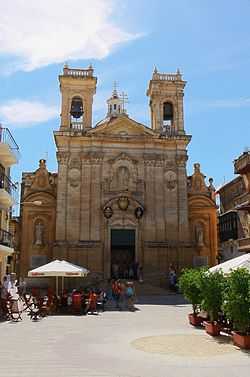St. George's Basilica, Malta
| Basilica of Saint George | |
|---|---|
| The Pontifical Collegiate Basilica Arch-Matrix and Proto-Parish Church of Saint George | |
| Il-Knisja Proto-Parrokkjali u ArċiMatriċi Bażilika u Kolleġġjata Lateranensi In Urbe ta' San Ġorġ | |
|
Exterior of St George's Basilica | |
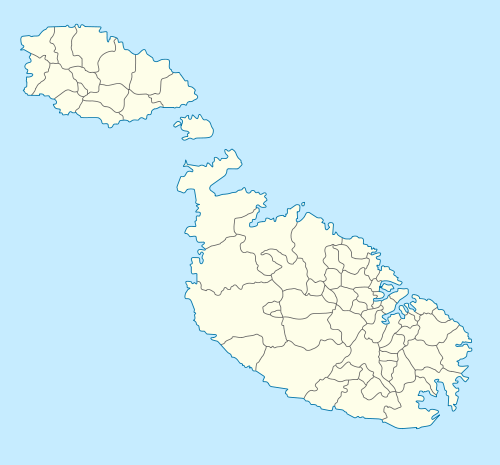 Basilica of Saint George Location within Malta | |
| 36°2′38.52″N 14°14′20.68″E / 36.0440333°N 14.2390778°E | |
| Location |
|
| Country |
|
| Denomination | Roman Catholic |
| Website | Website of the Basilica |
| History | |
| Founded |
1672 (present church) Unknown (Parish of St George) |
| Dedication | Saint George |
| Consecrated | 21 September 1755 |
| Events |
6 September 1958 (Became a Minor Basilica) 8 December 1975 (Became a Pontifical Collegiate church) |
| Architecture | |
| Status | Active |
| Functional status | Collegiate Parish Church |
| Architect(s) | Vittorio Cassar |
| Architectural type | Church |
| Style | Baroque |
| Years built | 1672 - 1678 |
| Completed | 1678 |
| Specifications | |
| Number of domes | 10 |
| Number of spires | 2 |
| Bells | 5 (1925) |
| Administration | |
| Parish | Victoria, Malta |
| Metropolis | Archdiocese of Malta |
| Diocese | Diocese of Gozo |
| Province | Malta |
| Clergy | |
| Bishop(s) | Mario Grech |
| Dean | Mario Grech |
| Archpriest | Paul Cardona |
| Precentor | Karm Grech |
| Chancellor | Felix Tabone |
| Canon Treasurer | Carmelo Scicluna |
| Laity | |
| Director of music | George Frendo |
| Organist(s) | Dr. Maria Frendo |
| Music group(s) | Laudate Pueri Choir |
 | |
St George's Basilica is situated in the middle of Victoria, the ancient "Ħaġar" – the capital of Gozo, the second largest island in the Maltese archipelago, and is surrounded by a maze of old narrow streets and alleys. Today's basilica was built between 1672 and 1678.
History
The parish originated in Byzantine times, but it is documented in manuscript sources only in c. 1250, when it is recorded functioning as a parish church. St George's was also listed as one of the parishes in Gozo where indulgences could be obtained on a papal bull by Pope Nicholas V for the Holy Year of 1450. In fact till 1575 the liturgy in St George's parish church was celebrated in the Byzantine Rite rather than the Latin Rite. It was the last church to celebrate the Byzantine liturgy in the island until the transition to the Roman rite. The foundation stone of the present church was laid on 7 August 1672 and it was consecrated on 21 September 1755 by Bishop Paul Alphéran de Bussan. At the time it was the largest Christian church on the island. Records of the visitation of Archbishop Paul Alphéran de Bussan in 1744, claim that St George's Church is one of the first parishes erected in the Diocese of Malta.
The Union of the two parishes
In 1630 the Vicar general of the Diocese of Malta, Pier Francesco Pontremoli, proposed the union of the two parishes of Gozo - that of the Assumption in the Citadel and that of St George - because of conflicts and competitions that the two parish priests of the respective parishes where initiating. Thus it was decided that the administration of the parish of St George be put under the authority of the archpriest of the Assumption church. But such a union was not possible if a valid reason was not identified. In the meantime the parish church of St George was rebuilt and finished in 1678. It was on April 28, 1688 that Bishop Davide Cocco Palmieri established four new parishes in Gozo and united the two parishes of Rabat. This union took place out of avarice and conspiracy for power and wealth. This union went on for the next 266 years until August 1, 1955 when the Bishop of Gozo, Giuseppe Pace, dissolved this unjust union between the two parishes by signing the decree Cum hodiernis temporibus where he returned to the parish of St George the freedom that it needed to carry out its pastoral activity.[1]
Enlargement
In the 1930s the church was enlarged with the addition of the naves and the side chapels. Between 1939 and 1940 the dome of the church was reconstructed due to damage done in the earthquakes of 1693 and 1789. The roof was also rebuilt and reconstructed in the Roman style arch between 1938 and 1939. The inauguration of the enlarged church took place on July 28, 1940 by Bishop Mikiel Gonzi.
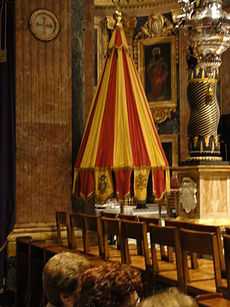
Minor Basilica
On 6 September 1958 Archpriest Cefai announced to the gathered congregation that the church was honoured with the title of Basilica. The decree, Merito dilaudatur templum, dated 6 September 1958, confirmed Pope Pius XII's decision that the parish church was now a Basilica, the first parish church in Gozo to be elevated to this dignity.[2] With this title the church received certain privileges such as precedence before other churches, the right of the Umbraculum and the Tintinnabulum. These objects are carried in every procession that the collegiate chapter takes part in. Also the church acquired the right to include the papal symbol of the crossed keys on a basilica's banners, furnishings and seal.
Collegiate church
On December 8, 1975 Bishop Nikol Joseph Cauchi established the first collegiate chapter of the new Pontifical Collegiate church. He decreed that the Collegiate church would be aggregated to the Cathedral Archbasilica of St. John Lateran of Rome. In total Gozo has 5 collegiate chapters all with their peculiar privileges and insignia. But the pontifical collegiate chapter of St George's has the unique privilege of having the bishop of Gozo of the time as its Dean and First Dignitary, as decreed by Bishop Cauchi. Thus it is the only Pontifical Collegiate Chapter in the diocese.
Works of Art

This parish church is referred to as "the golden church" of Gozo. It is entirely covered with marble and gold stucco. The church houses two works of art by the famous painter Mattia Preti. These are the main altar piece representing St George with the dragon and the other in a side chapel representing the Holy Souls.
Titular altarpiece
In 1678 the Governor of Gozo Don Francesco de Corduba commissioned a new altarpiece for the parish church of St George from Mattia Preti. This painting is considered to be one of Gozo's most important painting. The painting depicts St George triumphant over the dragon. It is interesting to note the coat of arms of the donor that the artist depicts in the bottom left corner of the painting.
Other altarpieces
Other works of art include two paintings depicting Saint Catherine of Alexandria and St Lazarus respectively, both by Giuseppe D'Arena. Giuseppe Calì painted the picture of the Holy Family for the Basilica in 1899. St Michael is depicted in a mosaic made in Rome in 1963 based on an older painting. Stefano Erardi left his mark when he painted the picture of St Paul found in the first left chapel when entering the Basilica from the main door.

Interior renovation
Between 1945 and 1954 the church underwent major changes that changed its internal appearance. In 1945 work started on the decoration of the copula of the church. The paintings in the copula represent the theme of victory from the Book of Revelation. They were painted by Giovanni Battista Conti while the stucco decoration was done by Giuseppe Galea. Conti also designed 8 stained glass windows which decorate the dome. The dome was inaugurated in 1949. That same year a new set of Stations of the Cross, carved from marble and brought from Rome, were inaugurated. They were designed by Carlo Pisi and sculpted by Henreaux of Lucca. In 1952 work started on the decoration of the naves while the newly redecorated organ gallery was finished.
In 1960 a new main altar was dedicated. It was made from white Carrara marble on the design of Carlo Pisi. The altar depicts four angels wearing clerical vestments on their knees while lifting the horizontal piece of the altar on their shoulders. This was the first altar table in Gozo to be dedicated in any church. The bronze and gold gilded canopy over the high altar is indeed impressive. It was made in 1967 following the liturgical reform promulgated by the Second Vatican Council. The canopy was based on the design of Bernini's in St Peter's Rome. But the main attraction is the wooden statue of the patron saint, St George, sculpted in wood by Pietru Pawl Azzopardi in 1838. It was the first titular statue acquired by a parish church in Gozo. Modern-style artistic bronze portals designed by Gozitan artist John L. Grima and cast in Verona, Italy, were installed in 2004.
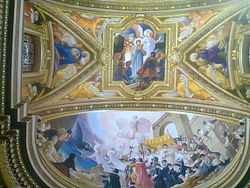
All paintings in the dome and ceiling are by Prof. Giovanni Battista Conti of Rome. Mattia Preti, Giuseppe Calì, Michele Busuttil, Giuseppe Fenech, Francesco V. Zahra, Fortunato Venuti, Injazju Cortis, Ramiro Calì, Filippo Cosimo, Giuseppe D'Arena, Salvatore Bondì, Robert Dingli, Stefano Erardi, Alessio Erardi and Alfred Camilleri Cauchi are other famous artists whose works can be admired in the basilica and its annexes. The church also possesses the whole corpse of St Clement lying inside one of the side altars.
Medieval Ciborium
In 1816, during demolition and reconstruction works on the façade of the Basilica, a very old ciborium was discovered hidden in the walls of the church. The ciborium dates from Medieval times and is mentioned in various manuscripts and records about the parish church. Today the ciborium is kept at the Gozo Cathedral Museum.
Byzantine Chapel
Something which one may not expect to see in a traditionally classic and Baroque building such as St George's is a Byzantine style chapel. The cornerstone was laid in 2002. Today this chapel holds the Blessed Sacrament and the Holy Cross of the Basilica. In 2004 work started on the building of the new dome of the chapel. The chapel was blessed by the then Archpriest Dr Joseph Farrugia on July 10, 2005.[3] This unusual style was chosen for its cultural association with the Christian Churches of the East. The aim was to help instil in the Catholic faithful the awareness that the universal Church breathes through two lungs, that of the Western Church as well as that of Eastern Christianity. The chapel and the dome were build on the designs of Vince Centorrino. The dome includes eight Byzantine style windows and is decorated with gold mosaic. The floor of the chapel is covered with porphyry slabs.[4] The chapel also includes a solid silver tabernacle, 7 feet tall. It was build in the form of the ancient ciborium that was in use in St George’s up to the sixteenth century when it was lost but retrieved again when it was found buried in the old façade of the basilica, some two centuries later.[5]

Bronze Door
In 2004 the new main door of the Basilica was inaugurated by Bishop Nikol Joseph Cauchi. The door, named Porta Salutis, is made entirely of bronze and was manufactured in Verona on a design by John Grima. The door features a total of 8 designs, with the coat of arms of Pope John Paul II in the middle since it was during his pontificate that door was inaugurated. The bronze door is the only one in the entire island of Gozo.
Events and Services
The Basilica is the host of various events such as:
Feast of St George
The liturgical feast of St George Martyr, protector of the island of Gozo and patron saint of the city, falls on 23 April, but external festivities are celebrated with great pomp in the city during the week leading to the third Sunday of July.[6]
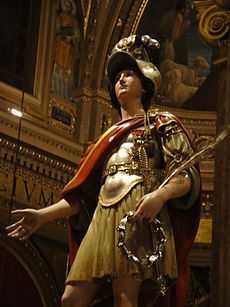
Victoria International Arts Festival
The Basilica also hosts 5 weeks of cultural events from mid June till mid July. The Victoria International Arts Festival is a non-profit organization that makes these events possible.[7] All concerts and events are free of charge.[8]

Religious Services
But first and foremost the Basilica is a place of worship. Services start as early as 5.15am on Weekdays and at 5.00am on Sundays. Services are celebrated at frequent intervals throughout the morning and in the evening and people come from all over the island knowing that St George’s basilica is always open to welcome them. The Basilica is considered to be the busiest parish on the island. In December the Basilica celebrates the Christmas novena, which are 9 days of festivities that lead to the feast of Christmas. The Christmas Midnight mass is attended by hundreds of faithful from all over the country to the extent where there is no more space for people to fit inside the church. Another novena is celebrated in preparation for the feast of the patron Saint George which also draws many people through doors of the basilica.
Basilica Museum
In February 2013 the Basilica opened the doors to its new modern museum, one of a kind in the country. It is the first building built for the purpose of a museum. The Museum and cultural centre, named as Heart of Gozo: Il-Hagar, displays a rich collection of historical and artistic artefacts previously inaccessible to the general public. The museum also hosts cultural events from time to time and also exhibits temporary exhibitions.[9] The museum is found on the left side of the Basilica. The curator of the museum is the Rev. Mgr. Dr. Joseph Farrugia, Archpriest emeritus of the Basilica.
Sistine Chapel Choir
The Basilica was also the place where various world famous choirs performed, among these one can mention the Sistine Chapel Choir who performed a concert of sacred music. The first time the choir visited the Basilica was in 2006, when on April 23, the liturgical feast of St George, the choir sang works by Palestrina, Victoria, Perosi, Bartolucci, and Liberto.[10][11] The second time the choir visited the church was on 23 February 2013, as part of the celebrations of the opening of the new museum, Heart of Gozo: Il-Hagar.[12][13] Interesting to note is that this was the last time that the Sistine Chapel Choir sang during the pontificate of Pope Benedict XVI, who resigned five days later. The Basilica is also privileged to be the only church on the island of Gozo where the Papal choir has performed.
Important Dates
- April 23: Solemnity of Saint George
- September 6: Anniversary of the elevation of the church as a Basilica
- September 14: Feast of the Exaltation of the Holy Cross
- September 22: Anniversary of the Dedication of the church
- September 29: Feast of Saint Michael
- December 8: Anniversary of the establishment of the Collegiate chapter
Recent Archpriests
From 1688 until 1975 there was only one archpriest for the two parishes of Victoria. This was because of the union of the two parishes that took place in 1688. Thus the priest in charge was known as the Archpriest of Victoria. The first Archpriest of St George since 1688 was Emmanuel Mercieca who became archpriest in 1975 upon the death of his predecessor Michael Cefai who was the last Archpriest of Victoria.
- Rev. Mgr Paul Cardona (2007–present)
- Rev. Mgr Dr Joseph Farrugia (1998–2007)
- Rev. Mgr Salv Borg (1986–1998)
- Rev. Mgr Emmanuel Mercieca (1975–1986)
- Rev. Mgr Michael Cefai (1944–1975)
- Rev. Mgr Alfons Maria Hili (1917–1944)
- Rev. Mgr Feliċ Refalo (till 1917)
Collegiate Chapter
On December 8, 1975 Bishop Nikol Joseph Cauchi established the first collegiate chapter of canons of St George's. The present chapter has a total of 15 members.
- Most Rev. Mario Grech - Dean
- Rev. Mgr. Paul Cardona - Archpriest
- Rev. Mgr. Dr Joseph Farrugia - Archpriest Emeritus
- Rev. Mgr. Carmelo Scicluna - Treasurer
- Rev. Mgr. Karm Grech - Precentor
- Rev. Mgr. Francis Xavier Calleja -Primicerius
- Rev. Can. Giovanni Mercieca - Penitentiary
- Rev. Mgr. Felix Tabone - Chancellor
- Rev. Can. Giovanni Gauci
- Rev. Can. Joseph A. Borg
- Rev. Can. George DeBrincat
- Rev. Can. Francis M. Vella
- Rev. Can. George J. Frendo
- Rev. Can. Emanuel Buttigieg
Gallery
-

View of St George's from the Citadel
-

Interior of the Basilica
-

St George in glory by Giovanni Battista Conti situated in the apse of the Basilica completed in 1955.
-

The dome paintings by Gian Battista Conti.
-

The Martyrdom of St George by Giovanni Battista Conti
-

Copula of the side chapel of the Holy Family.
-
.jpg)
Detail of the canopy.
-

The interior of the main dome.
-

Apse painting showing the deliverance of Gozo from the plague by the intercession of St George.
-

The Holy Family by Giuseppe Calì.
Sources
- http://www.gozo.gov.mt/
- http://www.stgeorge.org.mt/
- http://www.heartofgozo.org.mt/
- http://www.lbv104.com/
- http://www.viaf.org.mt/
- https://www.facebook.com/stgeorge.org.mt
External links
| Wikimedia Commons has media related to Saint George Basilica, Victoria. |
References
- ↑ "Today… Honour to the honourable!", Website of St George's Basilica, Malta, 01 August 2006. Retrieved on 19 April 2014.
- ↑ "St George's Basilica: fifty years old", Website of St George's Basilica, Malta, 06 September 2008. Retrieved on 19 April 2014.
- ↑ "New chapel blessed by Archpriest Mgr Joseph Farrugia", Website of St George's Basilica, Malta, 10 July 2005. Retrieved on 21 April 2014.
- ↑ "Byzantine chapel paved with precious porphyry slabs", Website of St George's Basilica, Malta, 14 March 2007. Retrieved on 21 April 2014.
- ↑ "New tabernacle received with praise", Website of St George's Basilica, Malta, 18 July 2007. Retrieved on 21 April 2014.
- ↑ "ST GEORGE’S ANNUAL FESTA" Retrieved on 08 March 2014.
- ↑ Borg, Annaliza."Victoria International Arts Festival: A Month of musical excellence", The Malta Independent, Malta, 08 June 2012. Retrieved on 08 March 2014.
- ↑ "Victoria International Arts Festival", The Times of Malta, Malta, 10 June 2013. Retrieved on 08 March 2014.
- ↑ "Museum-cum-cultural centre opened in Victoria", The Times of Malta, Malta, 24 February 2013. Retrieved on 08 March 2014.
- ↑ Castelain. "Vatican Choir at Gozo Basilica", The Times of Malta, Malta, 14 May 2006. Retrieved on 08 March 2014.
- ↑ "A memorable Sistine Chapel Choir in St George’s basilica", Malta, April 26, 2006. Retrieved on 08 March 2014.
- ↑ "Vatican’s Sistine Chapel Choir to perform in Gozo", Malta Star, Malta, 18 February 2013. Retrieved on 08 March 2014.
- ↑ "Papal Choir concert during Museum inauguration weekend", Gozo News, Malta, 14 February 2013 . Retrieved on 08 March 2014.
36°02′38.52″N 14°14′20.68″E / 36.0440333°N 14.2390778°ECoordinates: 36°02′38.52″N 14°14′20.68″E / 36.0440333°N 14.2390778°E
